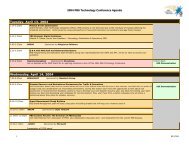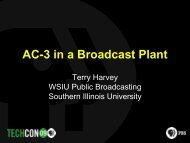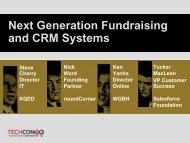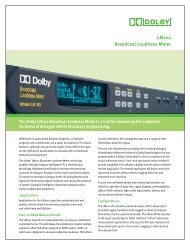PBS Business Continuity & Disaster Recovery
PBS Business Continuity & Disaster Recovery
PBS Business Continuity & Disaster Recovery
Create successful ePaper yourself
Turn your PDF publications into a flip-book with our unique Google optimized e-Paper software.
<strong>PBS</strong> <strong>Business</strong> <strong>Continuity</strong><br />
&<br />
<strong>Disaster</strong> <strong>Recovery</strong><br />
April 2011
<strong>PBS</strong> BCP & <strong>Disaster</strong> <strong>Recovery</strong><br />
• <strong>PBS</strong> Distribution Services & Workflow<br />
• BCP / DR Initiatives<br />
• <strong>Recovery</strong> Solutions<br />
• Satellite / Transponder <strong>Recovery</strong><br />
• <strong>PBS</strong> DRS Facility<br />
• “Do-it-yourself” DR plan template<br />
• Q&A<br />
2
<strong>PBS</strong> BCP & <strong>Disaster</strong> <strong>Recovery</strong><br />
Stefan Petrat<br />
VP, Distribution Operations & Engineering<br />
Thomas Crowe<br />
Sr. Director, Technology<br />
James Cutright<br />
Sr. Project Manager Interconnection<br />
Cindy Jackson<br />
Director, Operations Strategic Planning & BCP<br />
3
<strong>PBS</strong> Distribution Services<br />
• <strong>PBS</strong> has been providing signals to the member stations from the <strong>PBS</strong><br />
Technology Center in Springfield Virginia since 1978.<br />
• The <strong>PBS</strong> Technology Center is comprised of Network Operations (NOC)<br />
and Technical Maintenance (TMC) services.<br />
• <strong>PBS</strong>’s Technology Center currently originates and uplinks 11 digital video<br />
services, including two 24-hour a day HD feeds and two HD “soft” feeds.<br />
These digital services are transmitted to three different satellites over both<br />
Ku and C-Band satellite transponders.<br />
• The <strong>PBS</strong> Tech Center is located 12 miles southwest of downtown<br />
Washington DC near Springfield, Virginia on five acres of land owned by<br />
<strong>PBS</strong>. Two buildings on campus;<br />
• SOC-1 used for NOC & SOC operations<br />
• SOC-2 used for TMC, Lab and administration.<br />
4
<strong>PBS</strong><br />
Technology Center<br />
SOC-2<br />
SOC-1 Building<br />
SOC-1<br />
SOC-2 Building<br />
5
<strong>PBS</strong> BCP & <strong>Disaster</strong> <strong>Recovery</strong><br />
Distribution Services & Workflow<br />
6
<strong>PBS</strong> Distribution Services<br />
• Real-time Services<br />
• NPS services: HD01, HD02<br />
• Soft services: HD03, HD04, SD01<br />
• VMe, Create, World: SD02, SD03, SD04<br />
• Tape feeds, Ingest & Live Turn-around<br />
• Content QC<br />
• Satellite Access Coordination<br />
• HD04, SD05, SD06, SD07<br />
• <strong>Disaster</strong> <strong>Recovery</strong> / <strong>Business</strong> <strong>Continuity</strong><br />
• Engineering & Lab<br />
• Non Real-time<br />
• Supporting development & testing<br />
• Facilities support<br />
7
<strong>PBS</strong> Distribution Services<br />
<strong>PBS</strong> Workflow - Overview<br />
Telstar 5<br />
Transponder 25V (KU)<br />
8
<strong>PBS</strong> Distribution – Ku Band<br />
AMC-21 Tx22<br />
Contract End: 09/2016<br />
Bandwidth: 36Mhz<br />
Modulation: DVB-S2 8PSK<br />
MCPC – MPEG2<br />
Fully Protected<br />
Services<br />
1. HD01<br />
2. HD02<br />
AMC-21 Tx23<br />
Contract End: 09/2016<br />
Bandwidth: various<br />
Modulation: DVB-S QPSK<br />
SCPC – MPEG2<br />
Transponder Protected<br />
Services<br />
1. HD04 (18Mhz)<br />
2. SD05 (6Mhz)<br />
3. SD06 (6Mhz)<br />
4. SD07 (6Mhz)<br />
AMC-21 Tx24<br />
Contract End: 09/2016<br />
Bandwidth: 36Mhz<br />
Modulation: DVB-S QPSK<br />
MCPC – MPEG2<br />
Fully Protected<br />
Services<br />
1. HD03<br />
2. SD01<br />
3. SD02 (Create)<br />
4. SD03 (VMe)<br />
5. SD04 (World)<br />
AMC-21<br />
125W Ku Band<br />
Vendor: SES World Skies<br />
Satellite EOL: 10/2022<br />
AMC-21 Tx20<br />
Contract End: 09/2013 & 03/2014<br />
Bandwidth: various<br />
Modulation: various<br />
SCPC<br />
Transponder Protected<br />
Services<br />
1. Montana <strong>PBS</strong> (6Mhz)<br />
2. Oklahoma <strong>PBS</strong> (10.75Mhz)<br />
AMC-21 Tx21<br />
Contract End: 09/2016<br />
Bandwidth: 36Mhz<br />
Modulation: DVB-S QPSK<br />
SCPC<br />
Transponder Protected<br />
Services<br />
1. NRT<br />
9
<strong>PBS</strong> BCP & <strong>Disaster</strong> <strong>Recovery</strong><br />
<strong>Business</strong> <strong>Continuity</strong><br />
&<br />
<strong>Disaster</strong> <strong>Recovery</strong><br />
Initiatives<br />
10
<strong>PBS</strong> BCP & <strong>Disaster</strong> <strong>Recovery</strong><br />
• “Evergreen” emergency playback unit installed at Nebraska<br />
• 48 hours of content available on a video server for instant access & availability<br />
• Replaced older DVD system and updated program content<br />
• Status: Completed<br />
• Completion date: June 2010<br />
• Initial Response Team (IRT) Drill<br />
• Scenario based “table top” exercise with <strong>PBS</strong> senior executives<br />
• Status: Completed<br />
• Completion date: August 2010, another drill targeted for mid 2011<br />
• Satellite Phone Test<br />
• Annual verification of backup communication system<br />
• Status: Completed<br />
• Completion date: August 2010<br />
11
<strong>PBS</strong> BCP & <strong>Disaster</strong> <strong>Recovery</strong><br />
• NOC / SOC Evacuation Drills<br />
• Level 1 … “Remote control” of Tech Center from Crystal City via MOC<br />
• Status: Completed & Ongoing<br />
• Completion date: June 2010 & September 2010<br />
• Level 2 … Program origination and satellite distribution from Crystal City via<br />
MOC<br />
• Status: Completed & Ongoing<br />
• Completion date: November 2010 & February 2011<br />
• Satellite <strong>Disaster</strong> <strong>Recovery</strong> Plan update<br />
• Update, confirm and initiate recovery solution for satellite and/or transponder<br />
failures<br />
• Status: Completed<br />
• Completion date: December 2010<br />
12
<strong>PBS</strong> BCP & <strong>Disaster</strong> <strong>Recovery</strong><br />
• BCP Software / Crisis Communication update<br />
• “<strong>Recovery</strong> Planner” will text or email alert staff of issues and desired actions<br />
• Company-wide testing has taken place to confirm the system functions as expected<br />
• “Canned” messages have been loaded into the application<br />
• Cindy worked with Anne & Jan in Communications to approve messages for various emergencies<br />
• Personnel information update (e.g. mobile phone, home phone, contact details<br />
etc.) is in process on a department by department basis<br />
• T&O and Interactive were done first since they represent a third of the company. Remainder of company completed; All<br />
Staff email from COO with instructions and to reflect importance of task.<br />
• Status: Completed<br />
• Completion date: February 2011<br />
• IT <strong>Recovery</strong> Solution Project<br />
• Review critical business systems & department priorities and needs<br />
• Determine next steps and cost for multi-year capx project starting in FY2012<br />
• Status: In progress<br />
• Completion date: May 2011<br />
13
<strong>PBS</strong> BCP & <strong>Disaster</strong> <strong>Recovery</strong><br />
<strong>Recovery</strong> Scenarios<br />
14
<strong>PBS</strong> BCP & <strong>Disaster</strong> <strong>Recovery</strong><br />
“Normal operations”<br />
Telstar 5<br />
Transponder 25V (KU)<br />
Member<br />
Station<br />
15
<strong>PBS</strong> BCP & <strong>Disaster</strong> <strong>Recovery</strong><br />
“Evacuation of Tech Center”<br />
Telstar 5<br />
Transponder 25V (KU)<br />
Member<br />
Station<br />
16
<strong>PBS</strong> BCP & <strong>Disaster</strong> <strong>Recovery</strong><br />
“Loss of Tech Center”<br />
Telstar 5<br />
Transponder 25V (KU)<br />
Member<br />
Station<br />
17
<strong>PBS</strong> BCP & <strong>Disaster</strong> <strong>Recovery</strong><br />
“Loss of Satellite or Transponder”<br />
Telstar 5 Telstar 5<br />
Transponder 25V Transponder (KU) 25V (KU)<br />
18
<strong>PBS</strong> BCP & <strong>Disaster</strong> <strong>Recovery</strong><br />
“Loss of <strong>PBS</strong> HQ – Crystal City”<br />
Telstar 5<br />
Transponder 25V (KU)<br />
Member<br />
Station<br />
19
<strong>PBS</strong> BCP & <strong>Disaster</strong> <strong>Recovery</strong><br />
“Overview of Future Operations”<br />
Telstar 5<br />
Transponder 25V (KU)<br />
Member<br />
Station<br />
Operational<br />
est. CY2012 / 13<br />
(capx FY2012 / 13)<br />
Operational<br />
Q3/Q4-CY2011<br />
(capx FY2011)<br />
20
<strong>PBS</strong> BCP & <strong>Disaster</strong> <strong>Recovery</strong><br />
Satellite / Transponder<br />
<strong>Recovery</strong><br />
21
<strong>PBS</strong> BCP & <strong>Disaster</strong> <strong>Recovery</strong><br />
Transponder failure<br />
“ … loss of a single or multiple transponders on a satellite …”<br />
Satellite failure<br />
“ … loss of at least 13 or more transponders on a satellite…”<br />
22
<strong>PBS</strong> BCP & <strong>Disaster</strong> <strong>Recovery</strong><br />
AMC-21 Tx22<br />
Contract End: 09/2016<br />
Bandwidth: 36Mhz<br />
Modulation: DVB-S2 8PSK<br />
MCPC – MPEG2<br />
Fully Protected<br />
Services<br />
1. HD01<br />
2. HD02<br />
AMC-21 Tx23<br />
Contract End: 09/2016<br />
Bandwidth: various<br />
Modulation: DVB-S QPSK<br />
SCPC – MPEG2<br />
Transponder Protected<br />
Services<br />
1. HD04 (18Mhz)<br />
2. SD05 (6Mhz)<br />
3. SD06 (6Mhz)<br />
4. SD07 (6Mhz)<br />
AMC-21 Tx24<br />
Contract End: 09/2016<br />
Bandwidth: 36Mhz<br />
Modulation: DVB-S QPSK<br />
MCPC – MPEG2<br />
Fully Protected<br />
Services<br />
1. HD03<br />
2. SD01<br />
3. SD02 (Create)<br />
4. SD03 (VMe)<br />
5. SD04 (World)<br />
AMC-21<br />
125W Ku Band<br />
Vendor: SES World Skies<br />
Satellite EOL: 10/2022<br />
AMC-21 Tx20<br />
Contract End: 09/2013 & 03/2014<br />
Bandwidth: various<br />
Modulation: various<br />
SCPC<br />
Transponder Protected<br />
Services<br />
1. Montana <strong>PBS</strong> (6Mhz)<br />
2. Oklahoma <strong>PBS</strong> (10.75Mhz)<br />
AMC-21 Tx21<br />
Contract End: 09/2016<br />
Bandwidth: 36Mhz<br />
Modulation: DVB-S QPSK<br />
SCPC<br />
Transponder Protected<br />
Services<br />
1. NRT<br />
23
AMC-21 - 125 o W<br />
Transponder Failure <strong>Recovery</strong><br />
Rank<br />
4<br />
AMC-21<br />
(Tx20 V)<br />
Montana / Oklahoma<br />
AMC-21<br />
Spare Transponder<br />
(same polarity)<br />
5<br />
(Tx21 H)<br />
NRT<br />
Spare Transponder<br />
(same polarity)<br />
1<br />
(Tx22 V)<br />
HD01 & HD02<br />
Spare Transponder<br />
(same polarity)<br />
3<br />
(Tx23 H)<br />
HD04, SD05, SD06, SD07<br />
Spare Transponder<br />
(same polarity)<br />
2<br />
(Tx24 V)<br />
HD03, SD01, SD02, SD03, SD04<br />
Spare Transponder<br />
(same polarity)<br />
For one or more transponder failures, spare components on the space craft are first used.<br />
If spares are not available, <strong>PBS</strong> has the right to pre-empt another service from their transponder.<br />
Currently there are 8 spare transponders on AMC-21<br />
24
AMC-21 - 125 o W<br />
Satellite Failure <strong>Recovery</strong><br />
Rank<br />
1<br />
2<br />
AMC-21<br />
(Tx22 V)<br />
HD01 & HD02<br />
(Tx24 V)<br />
HD03, SD01, SD02, SD03, SD04<br />
AMC-1<br />
(Tx18V)<br />
HD01 (HD Packaged)<br />
SD01, SD02, SD03, SD04<br />
3<br />
(Tx23 H)<br />
HD04, SD05, SD06, SD07<br />
(Tx16V)<br />
HD03 (HD Soft)<br />
SD05, SD06, SD07,<br />
HD04<br />
Full details of this recovery scenario are available on <strong>PBS</strong> Connect<br />
Connect > Engineer Compute > Distribution Operations Engineering > <strong>Disaster</strong> Recover Plan<br />
25
<strong>PBS</strong> BCP & <strong>Disaster</strong> <strong>Recovery</strong><br />
AMC-1 Tx20<br />
103W C Band<br />
Vendor: SES World Skies<br />
Satellite EOL: 01/2015<br />
Contract End: 09/2016<br />
Bandwidth: 18Mhz<br />
Modulation: DVB-S QPSK<br />
MCPC – MPEG2<br />
Transponder Protected<br />
Services<br />
1. <strong>PBS</strong> C-Band HD & SD<br />
26
AMC-1 - 103 o W<br />
Transponder Failure <strong>Recovery</strong><br />
Rank<br />
6<br />
AMC-1<br />
(Tx20 H)<br />
<strong>PBS</strong> HD& SD Digital Feed<br />
AMC-1<br />
Spare Transponder<br />
(same polarity)<br />
27
AMC-1 - 103 o W<br />
Satellite Failure <strong>Recovery</strong><br />
Rank<br />
AMC-1<br />
SES-1<br />
6 (Tx20 H)<br />
(Tx16 H)<br />
<strong>PBS</strong> HD& SD Digital Feed<br />
<strong>PBS</strong> HD& SD Digital Feed<br />
28
<strong>PBS</strong> BCP & <strong>Disaster</strong> <strong>Recovery</strong><br />
Uplink<br />
Freq<br />
Downlink<br />
Freq UL Mod Sym Rate<br />
Satellite Band Xpder Arc C/Ku (Mhz) L Band (Mhz) BW (Mhz) Pol Type FEC MS/s Services<br />
AMC-21 Ku 20 125 W 14404.00 1354.00 6 V<br />
DVB-S<br />
QPSK<br />
AMC-21 Ku 20 125 W 14412.50 1362.50 10.75 V DVB-S2<br />
8PSK<br />
AMC-21 Ku 21 125 W 14420.00 1370.00 36 H DVB-S2<br />
8PSK<br />
DVB-S<br />
AMC-21 Ku 22 125 W 14440.00 1390.00 36 V<br />
QPSK<br />
18<br />
AMC-21 Ku 23 125 W 14450.00 1400.00 18 H DVB-S<br />
QPSK<br />
AMC-21 Ku 23 125 W 14463.00 1413.00 6 H DVB-S<br />
QPSK<br />
AMC-21 Ku 23 125 W 14469.00 1419.00 6 H DVB-S<br />
QPSK<br />
AMC-21 Ku 23 125 W 14475.00 1425.00 6 H DVB-S<br />
QPSK<br />
AMC-21 Ku 24 125 W 14480.00 1430.00 36 V<br />
36<br />
DVB-S<br />
QPSK<br />
3/4 4.4444 Montana <strong>PBS</strong><br />
3/4 8.916 Oklahoma (OETA) U/L<br />
UNK UNK NRT Test<br />
3/4 30.000 MCPC - HD01 & HD02<br />
3/4 14.028732 HD04<br />
3/4 4.444 SD05 SCPC<br />
3/4 4.444 SD06 SCPC<br />
3/4 4.444 SD07 SCPC<br />
SES-1 C 16 101 W 6245.00 1130.00 36.00 V Analog N/A N/A Not used<br />
3/4 30.000 MCPC - HD03, SD01, SD02, SD03 & SD04<br />
AMC-1 C 20 103 W 6316.00 1059.00 18 H DVB-S<br />
QPSK<br />
3/4 14.028732 <strong>PBS</strong> C-Band HD & SD (Consumer use)<br />
29
<strong>PBS</strong> BCP & <strong>Disaster</strong> <strong>Recovery</strong><br />
Network Operations Center<br />
<strong>Disaster</strong> <strong>Recovery</strong> Site (DRS)<br />
30
<strong>PBS</strong> BCP & <strong>Disaster</strong> <strong>Recovery</strong><br />
<strong>Disaster</strong> <strong>Recovery</strong> Site (DRS)<br />
Purpose:<br />
… ‘The purpose of disaster recovery/business resumption project is to assure<br />
continuity of Network and Non-Realtime distribution operations needed to<br />
support critical system functions. The business resumption plan should aim at<br />
achieving a systematic and orderly resumption of all operational services. The<br />
plan should provide for a hot standby functionality between sites as well as<br />
restoring full service due to catastrophic failure as soon as possible. …’<br />
31
<strong>PBS</strong> BCP & <strong>Disaster</strong> <strong>Recovery</strong><br />
<strong>Disaster</strong> <strong>Recovery</strong> Site (DRS)<br />
<strong>Business</strong> Decision:<br />
… ‘Given the “<strong>PBS</strong> Satellite & Broadcast Operations <strong>Disaster</strong> <strong>Recovery</strong><br />
Planning Guide”, and the “Integrated Public Alert and Warning System<br />
(IPAWS)” that mandates a geographically separated facility, the decision to<br />
build and operate a DRS site seems to have been embraced. Also, as can be<br />
gleaned from the two papers, <strong>PBS</strong> has a business responsibility to its member<br />
stations and also the Federal Government in its IPAWS commitment.’ …<br />
32
Project Scope:<br />
<strong>PBS</strong> BCP & <strong>Disaster</strong> <strong>Recovery</strong><br />
<strong>Disaster</strong> <strong>Recovery</strong> Site (DRS)<br />
… ‘One of the major challenges facing the Public Broadcasting Service (<strong>PBS</strong>)<br />
today is preparing for the continuity of the system business following a possible<br />
catastrophic event that disables the operation of the Network Operations<br />
Center (NOC) facility.<br />
Whether referred to as “disaster recovery” or “business continuity”, such a<br />
contingency plan must be flexible enough to accommodate both short and longterm<br />
outages of the primary transmission site. At the same time, plans to<br />
survive an unlikely catastrophic event must also make sense within the<br />
economics of an ongoing business.’ ….<br />
33
<strong>PBS</strong> BCP & <strong>Disaster</strong> <strong>Recovery</strong><br />
Project Scope:<br />
• <strong>Business</strong> considerations<br />
<strong>Disaster</strong> <strong>Recovery</strong> Site (DRS)<br />
- What Do We Stand to Lose<br />
- How closely must the backup site replicate our primary site<br />
- What types of recovery scenarios are to be covered<br />
• Logistical<br />
- Staffing (UNL-TV, <strong>PBS</strong>)<br />
- Remote Operation (MOC, NOC)<br />
• Operational requirements<br />
- File Content Delivery & Sizing of Content Requirements<br />
- Control Data & Transfer Solution Component<br />
• Technologies<br />
34
<strong>PBS</strong> BCP & <strong>Disaster</strong> <strong>Recovery</strong><br />
Technology Solutions:<br />
1. Conventional apparatus<br />
2. IT/Software solution<br />
<strong>Disaster</strong> <strong>Recovery</strong> Site (DRS)<br />
Objectives for the DRS focused on:<br />
• Lower capital cost as compared to NOC<br />
• Simplicity of operation, including system compatibility of content files with NRT<br />
• Lower operational cost<br />
• Lower annual support costs<br />
Side benefit:<br />
• Confirmation of new technology for future upgrade of NOC site<br />
35
<strong>PBS</strong> BCP & <strong>Disaster</strong> <strong>Recovery</strong><br />
36
<strong>PBS</strong> BCP & <strong>Disaster</strong> <strong>Recovery</strong><br />
<strong>Disaster</strong> <strong>Recovery</strong> Site (DRS)<br />
DRS Equipment Center (DEC) …<br />
is a full function technical equipment center<br />
contained within the UNL-TV Nebraska facility. All<br />
equipment needed to support the DRS operation is<br />
contained within the DEC. The DEC operates on its<br />
own power (commercial & emergency generator)<br />
with full Uninterruptable Power Supply (UPS).<br />
Redundant HVAC units provide the necessary<br />
cooling and humidity control for the equipment and<br />
systems housed within the DEC. The equipment<br />
center is protected by a staged fire alarm system<br />
insuring the safety of systems and personnel.<br />
Within the DEC are equipment racks, work stations,<br />
tape storage shelves, cable trays, electrical<br />
distribution, grounding connections and access to<br />
UNL-TV’s cable trays which connect to their<br />
technical equipment center and satellite antenna<br />
farm.<br />
37
<strong>PBS</strong> BCP & <strong>Disaster</strong> <strong>Recovery</strong><br />
<strong>Disaster</strong> <strong>Recovery</strong> Site (DRS)<br />
<strong>PBS</strong> DRS Remote Operations position 1 & 2<br />
(PDRO1 & PDRO2) …<br />
Is a pair of remote operations positions located at<br />
the <strong>PBS</strong> NOC (PDRO1) in Alexandria, Va. and the<br />
<strong>PBS</strong> MOC (PDRO2) in Arlington, Va. Both<br />
positions will have full remote control of the DRS<br />
facility. PDRO1 will operate the DRS facility on a<br />
daily basis with PDRO2 being available in the event<br />
the NOC is disabled. In the event of an actual<br />
disaster involving the NOC, PDRO2 at the MOC will<br />
assume daily operations of the DRS Facility<br />
38
<strong>PBS</strong> BCP & <strong>Disaster</strong> <strong>Recovery</strong><br />
<strong>Disaster</strong> <strong>Recovery</strong> Site (DRS)<br />
DRS Network Operations Center (DNOC) …<br />
Is a full function operations facility located within the<br />
UNL-TV Transmission Center. It is the local<br />
operations, status, monitoring, alarm & control<br />
position in Lincoln, Ne. It will be the operations<br />
position during scheduled training operations,<br />
monthly satellite tests, and <strong>PBS</strong> Network<br />
Operations Center (NOC) maintenance or in the<br />
event of an actual disaster and the <strong>PBS</strong> NOC is<br />
disabled (either long term or short term).<br />
Laptop w/ Broadband & VPN Access …<br />
Is a full function operations workstation with full<br />
access to all applications and monitoring within the<br />
DRS. In a worse case scenario the DRS may be<br />
operated in this manner.<br />
39
<strong>PBS</strong> BCP & <strong>Disaster</strong> <strong>Recovery</strong><br />
<strong>Disaster</strong> <strong>Recovery</strong> Site (DRS)<br />
Terrestrial Interconnection Sub-system (TIS) …<br />
Means dedicated and internet based connectivity<br />
between the Media Operations Center (MOC) in<br />
Arlington, Va., the Network Operations Center<br />
(NOC) in Alexandria, Va. and University of<br />
Nebraska – Lincoln Television Department (UNL-<br />
TV) in Lincoln, Ne<br />
40
<strong>PBS</strong> BCP & <strong>Disaster</strong> <strong>Recovery</strong><br />
<strong>Disaster</strong> <strong>Recovery</strong> Site (DRS)<br />
Ku Band Satellite Uplink Transmission Subsystem<br />
(KSUTS) …<br />
Means an RF transmission system, housed within<br />
the UNL-TV satellite equipment shelter located in<br />
the “backyard” dish farm, consisting of DVB-S/S2<br />
QPSK/8PSK modulation sub-systems, IF-RF upconversion<br />
sub-systems, high power amplifier subsystems,<br />
automatic fault protection sub-systems,<br />
signal switching sub-systems, remote<br />
monitoring/control/alarm sub-systems,<br />
interconnected to satellite uplink antennas<br />
(including redundant antenna). We have exclusive<br />
use of this uplink chain and antenna, there will<br />
never be a conflict with UNL-TV?<br />
41
<strong>PBS</strong> BCP & <strong>Disaster</strong> <strong>Recovery</strong><br />
<strong>Disaster</strong> <strong>Recovery</strong> Site (DRS)<br />
C Band Satellite Uplink Transmission<br />
Sub-system (CSUTS) …<br />
Means an existing UNL-TV RF<br />
transmission system (fiber STL from UNL-<br />
TV Studio Building), contained within the<br />
UNL-TV satellite equipment shelter located<br />
near the Lincoln Municipal Airport (LNK)<br />
(including redundant antenna).<br />
42
<strong>PBS</strong> BCP & <strong>Disaster</strong> <strong>Recovery</strong><br />
<strong>Disaster</strong> <strong>Recovery</strong> Site (DRS)<br />
Real Time (RT) Program Origination Subsystem<br />
(POS) …<br />
Means a platform of equipment and software<br />
including but not limited to a traffic system,<br />
integrated ingest & play to air systems, signal<br />
processing sub-systems, SDI & IT switches &<br />
routers and IT management tools enabling the<br />
delivery of RT program streams to Public<br />
Television from UNL-TV Ne.<br />
Cache-Archive Sub-system (CAS) …<br />
Means a disk based cache & LTO tape<br />
based archive sub-system.<br />
43
<strong>PBS</strong> BCP & <strong>Disaster</strong> <strong>Recovery</strong><br />
<strong>Disaster</strong> <strong>Recovery</strong> Site (DRS)<br />
Non-Real Time (NRT)<br />
File Transfer System (FTS) …<br />
Means a platform of equipment and software<br />
enabling the delivery of NRT program files to Public<br />
Television Stations from UNL-TV Ne<br />
44
<strong>PBS</strong> BCP & <strong>Disaster</strong> <strong>Recovery</strong><br />
<strong>Disaster</strong> <strong>Recovery</strong> Site (DRS)<br />
Satellite Encoding/Mux Sub-system (SEMS) …<br />
Means a master control system that is designed<br />
to encode and multiplex multiple channels of SD<br />
and HD video into transport streams for<br />
distribution to Public Television Stations from<br />
UNL-TV Ne<br />
Local & remote Status, Monitoring, Alarm &<br />
Control sub-system (SMAC) …<br />
Means a platform of equipment and software<br />
enabling the control and monitoring, both locally<br />
and remotely, of the systems and services<br />
originating from or being distributed by the DRS<br />
facility<br />
45
<strong>PBS</strong> BCP & <strong>Disaster</strong> <strong>Recovery</strong><br />
<strong>Disaster</strong> <strong>Recovery</strong> Site (DRS)<br />
The following conditions are examples of DRS activation scenarios:<br />
NOC Diversity: In order to maintain <strong>PBS</strong> programs and services to PTV<br />
Stations the DRS will provide satellite uplink services whenever the NOC<br />
uplink is disabled by 1) sun transients, 2) rain-fades, 3) blizzard conditions, or<br />
any other naturally occurring phenomena.<br />
NOC Maintenance: In order to maintain <strong>PBS</strong> programs and services to PTV<br />
Stations the DRS will provide program origination and uplink services<br />
whenever the NOC facility is out of service for maintenance functions<br />
(scheduled event).<br />
NOC Emergency: In order to maintain <strong>PBS</strong> programs and services to PTV<br />
Stations the DRS will provide program origination and uplink services<br />
whenever the NOC facility is temporarily (short term) out of service due to an<br />
emergency condition.<br />
46
<strong>PBS</strong> BCP & <strong>Disaster</strong> <strong>Recovery</strong><br />
<strong>Disaster</strong> <strong>Recovery</strong> Site (DRS)<br />
The following conditions are examples of DRS activation scenarios:<br />
NOC <strong>Disaster</strong>: In order to maintain <strong>PBS</strong> programs and services to PTV<br />
Stations the DRS will provide program origination and uplink services if the<br />
NOC facility is rendered inoperable due to a catastrophic event.<br />
MOC/NOC <strong>Disaster</strong>: In order to maintain <strong>PBS</strong> programs and services to PTV<br />
Stations the DRS will provide content acquisition and management, program<br />
origination and uplink services if both the MOC and NOC facilities are<br />
rendered inoperable due to a catastrophic event.<br />
47
Original Concept:<br />
<strong>PBS</strong> BCP & <strong>Disaster</strong> <strong>Recovery</strong><br />
• Limited services (2 to 3 channels)<br />
• Legacy technology (automation, video servers, branding, …)<br />
• Parallel operation (in sync with NOC)<br />
• Restoration of supported services in < 15 mins<br />
• Remote control from <strong>PBS</strong> (NOC only)<br />
• Media based file delivery (LTO tape)<br />
• AS03 file format for distribution<br />
• Limited connectivity for:<br />
• Urgent file delivery only (limited by bandwidth)<br />
• Remote control<br />
<strong>Disaster</strong> <strong>Recovery</strong> Site (DRS)<br />
Past & Present: A Project History<br />
• Status and monitoring<br />
• System integrated into existing PTV facilities<br />
48
Site Selection:<br />
<strong>PBS</strong> BCP & <strong>Disaster</strong> <strong>Recovery</strong><br />
• RFP written and issued to PTV<br />
• PTV Stations responded<br />
• Responses review/evaluated<br />
• Site selected (UNL-TV, Lincoln, Ne)<br />
Technology Changes:<br />
• IT based Ingest & Play to Air systems emerged<br />
• Integrated systems on the market (multi-vendor)<br />
• Asset management included in integrated solutions<br />
• SD & HD capability<br />
• Client/Server architecture (Directly Supports Workstation Model)<br />
• Web based services<br />
<strong>Disaster</strong> <strong>Recovery</strong> Site (DRS)<br />
Past & Present: A Project History<br />
49
<strong>PBS</strong> BCP & <strong>Disaster</strong> <strong>Recovery</strong><br />
Technology Changes (Cont.):<br />
• Transcoding/Re-wrapping on IT server platforms comes of age<br />
• Lower initial investment as well as reduced operating costs<br />
New Concept for DRS:<br />
• Support the full bouquet of NOC services<br />
• HD01, HD02, HD03, HD04, SD01, SD02, SD03, SD04, SD05, SD06<br />
• Use DRS Uplink as Diversity Site<br />
• Rainfade, Sun Transient,…<br />
• Use IT technologies where applicable<br />
• S/W versus H/W solutions<br />
<strong>Disaster</strong> <strong>Recovery</strong> Site (DRS)<br />
Past & Present: A Project History<br />
• Play to Air, Ingest, Cache, Convert…<br />
• Use commodity versus proprietary H/W (<strong>PBS</strong> purchases H/W)<br />
• IT server platforms (multi CPU, multi-core, local cache…)<br />
• Commodity video cards (multi-vendor)<br />
• IT network switches, routers, VPN, …<br />
50
<strong>PBS</strong> BCP & <strong>Disaster</strong> <strong>Recovery</strong><br />
New Concept for DRS:<br />
• Client/Server architecture<br />
• Stream Monitoring Solution back to <strong>PBS</strong> (Multiviews, Desktops, …)<br />
• Workstation based operations (Desktop/Laptop)<br />
• DRS Lab at <strong>PBS</strong> (support S/W & H/W testing prior to implementation)<br />
Program Origination Subsystem (POS) Vendor Shoot-out:<br />
• DRS Design Document created<br />
• “Proof of Concept” Lab @ <strong>PBS</strong> (concepts tested and demonstrated)<br />
• RFB issued to vendors<br />
• Multi-vendors responded<br />
<strong>Disaster</strong> <strong>Recovery</strong> Site (DRS)<br />
Past & Present: A Project History<br />
• Three vendors participated in the Shoot-out<br />
• Two weeks allocated per vendor (1 wk setup, 1 wk test/eval)<br />
51
<strong>PBS</strong> BCP & <strong>Disaster</strong> <strong>Recovery</strong><br />
Program Origination Subsystem (POS) Vendor Shoot-out:<br />
• Demo/Evaluation conducted in Lab @ <strong>PBS</strong>, Alexandria<br />
• Results evaluated and scored<br />
• Vendors evaluated based on:<br />
• Scored performance,<br />
• Compliance to DRS model (design specification),<br />
• and business parameters (D&B, assets, …)<br />
• Vendor selected for DRS<br />
• GmbH, Munich, Germany<br />
Cache/Archive Subsystem (CAS):<br />
<strong>Disaster</strong> <strong>Recovery</strong> Site (DRS)<br />
Past & Present: A Project History<br />
• Centralized Disk Cache & Tape Archive Solution<br />
• Common to RT & NRT Systems<br />
• Commodity H/W based solutions<br />
52
<strong>PBS</strong> BCP & <strong>Disaster</strong> <strong>Recovery</strong><br />
Cache/Archive Subsystem (CAS):<br />
<strong>Disaster</strong> <strong>Recovery</strong> Site (DRS)<br />
Past & Present: A Project History<br />
• High Availability and Reliability Required<br />
• No standard off the shelf solution<br />
• Develop Solution with Vendor to support DRS<br />
• Test/Eval Proposed Solution in <strong>PBS</strong> Lab<br />
<strong>PBS</strong> DRS Connectivity (TIS):<br />
• Determine Bandwidth Requirements<br />
• Connectivity between MOC and DRS (File Delivery, Status/Mon/Alarm/Ctl)<br />
• Connectivity between NOC and DRS (Transport Streams, Status/Mon/Alarm/Ctl)<br />
• Evaluate, Test, and Demonstrate Available Solutions<br />
• Determine Best Quality Solution for DRS (BW vs $$$)<br />
53
<strong>PBS</strong> BCP & <strong>Disaster</strong> <strong>Recovery</strong><br />
<strong>Disaster</strong> <strong>Recovery</strong> Site (DRS)<br />
Past & Present: A Project History<br />
More new Technology for DRS:<br />
• IP based Status, Monitoring, Alarming (TS over IP)<br />
• Research Available Applications<br />
• Implement S/W Solutions where possible<br />
• Commodity H/W where applicable<br />
• Exception based monitoring/alarming<br />
• Decode SPTS and MPTS within Mon/Alarm Engines<br />
• Full support for Closed Captions & Annc Data<br />
• DVB Encode/Multiplex<br />
• Use TSoIP for Signal Transport<br />
• Use Ethernet (cabling, switches, vlans, …) to:<br />
• Interconnection (Encoder/Mux/Modulator)<br />
• Provide Full Redundancy<br />
• Support TSoIP Status/Monitoring/Alarming<br />
• Support Full Control & Configuration<br />
• Encode using S/W where viable<br />
• Multiplex using S/W where viable<br />
54
<strong>PBS</strong> BCP & <strong>Disaster</strong> <strong>Recovery</strong><br />
Status, Monitoring, Alarming and Control:<br />
• Local Monitoring, Alarming & Control<br />
• Remote Monitoring, Alarming & Control<br />
• Duplicate User Experience at <strong>PBS</strong> (MOC, NOC)<br />
• Support Baseband, ASI & TSoIP formats<br />
• Exception Based<br />
• Display HD/SD, Alarm on Faults<br />
• Display Audio bouquet (16 chs), Alarm on Faults<br />
• Display Closed Captions, Alarm on Faults (608/708)<br />
• Display Annc. Data (AFD, V-Chip, …), Alarm on Faults<br />
• Fault Tolerant Solution<br />
<strong>Disaster</strong> <strong>Recovery</strong> Site (DRS)<br />
Past & Present: A Project History<br />
55
<strong>PBS</strong> BCP & <strong>Disaster</strong> <strong>Recovery</strong><br />
MPEG4 Requirements:<br />
<strong>Disaster</strong> <strong>Recovery</strong> Site (DRS)<br />
Past & Present: A Project History<br />
• System must be MPEG4 Ready<br />
• Work with <strong>PBS</strong> MPEG4 Team to Eval/Demo/Test Systems<br />
RF System for DRS:<br />
• Design Signal System in Cooperation with UNL-TV<br />
• Use Existing Regional Uplink Infrastructure in Design<br />
• Integrate Additional Equipment & Systems to Support DRS<br />
• Design Control System Using Existing UNL-TV Technologies<br />
• Design for Joint Use of Uplink for DRS & Regional Services<br />
• Activate Diversity Site functionality as soon as possible<br />
56
<strong>PBS</strong> BCP & <strong>Disaster</strong> <strong>Recovery</strong><br />
Where we are at this time:<br />
<strong>Disaster</strong> <strong>Recovery</strong> Site (DRS)<br />
Past & Present: A Project History<br />
• The Agreement with UNL-TV is in place<br />
• The General Contractor has been hired<br />
• DRS Equipment Center (DEC) construction underway<br />
• The Program Origination (POS) Vendor is under Contract with <strong>PBS</strong><br />
• Pre-build of the POS Subsystem Racks at <strong>PBS</strong> is underway<br />
• Connectivity Solutions are being Tested/Eval’d at this time<br />
• RF Design in Support of Diversity Site Functionality is underway<br />
• We are in development for the Redundant Cache/Archive Subsystem (working w/<br />
Vendors)<br />
• Working with the MPEG4 Team, Test/Eval/Demo Vendor Solutions<br />
57
Project Goals:<br />
<strong>PBS</strong> BCP & <strong>Disaster</strong> <strong>Recovery</strong><br />
<strong>Disaster</strong> <strong>Recovery</strong> Site (DRS)<br />
Past & Present: A Project History<br />
• Diversity Site Capability no later than end of Q2, beginning of Q3<br />
• Power Up Full DRS no later than Q3 of 2011<br />
• Commence Staff Training (<strong>PBS</strong> & UNL-TV) in Q3, 2011<br />
• Parallel Operations no later than end of Q3, 2011<br />
• First Satellite Testing and Demonstration, during Q4, 2011<br />
• DRS Facility transferred to <strong>PBS</strong>/UNL-TV Operations, end of Q4<br />
• Project wrap-up and documentation completed by end of Q4, 2011<br />
58
Project Partners:<br />
<strong>PBS</strong> BCP & <strong>Disaster</strong> <strong>Recovery</strong><br />
• NGIS Project, The Grand Pobah!, Jerry Butler, Alexandria, Va<br />
• <strong>PBS</strong> Engineering & Operations, Stefan Petrat, Alexandria, Va<br />
• UNL-TV, Stacey Decker, Lincoln, Nebraska<br />
• HA Design Group, Consulting, Willy Halla, Springfield, Va<br />
• Caleca Consulting, MPEG4, Ed Caleca, Washington, DC<br />
• Burt Hill Architects, Scott Jones, Washington, DC<br />
• Cinegy GmbH, POS, Jan & Daniella Weigner, Munich, Germany<br />
• ABC Electric, Inc., General Contractor, Brad Wittstruck, Lincoln, Ne<br />
• JT Packard, UPS/GenSet, Dani Maher & Sam Shannon, Verona, WI<br />
• More to Come!!!<br />
<strong>Disaster</strong> <strong>Recovery</strong> Site (DRS)<br />
Thanks to All of You !!!<br />
59
<strong>PBS</strong> BCP & <strong>Disaster</strong> <strong>Recovery</strong><br />
“DIY”<br />
<strong>Disaster</strong> <strong>Recovery</strong> Template<br />
60
<strong>PBS</strong> BCP & <strong>Disaster</strong> <strong>Recovery</strong><br />
“Do-it-Yourself” DR Template<br />
•Organization of Document<br />
– Emergency Management Plan<br />
– <strong>Disaster</strong> <strong>Recovery</strong> Plan<br />
– “How-To” Document<br />
•Foundational Document<br />
– Building block for a complete business continuity plan<br />
•Published in <strong>PBS</strong> Connect (May 2010)<br />
– Engineer / Compute Technical Reference Library<br />
61
<strong>PBS</strong> BCP & <strong>Disaster</strong> <strong>Recovery</strong><br />
• Emergency Management is pre-determined actions that are<br />
performed immediately following emergency responders to an<br />
incident and before recovery. It is designed to create a “state of<br />
readiness” for an organization to function and begin a strategic,<br />
orderly recovery, avoiding confusion and reducing exposure to error.<br />
It is also known as Crisis Management.<br />
• Emergency Management Plan<br />
– Crisis Manager role and responsibilities<br />
– Emergency Teams roles and actions to perform<br />
• Initial Response Team<br />
• Emergency Management Team<br />
• Logistics Support Team<br />
• Emergency Response Team<br />
“Do-it-Yourself” DR Template<br />
EMERGENCY MANAGEMENT PLAN<br />
62
Team Activation During a Crisis<br />
I N C I D E N T<br />
Activate Emergency Procedures<br />
Building Evacuation (ERT). Security<br />
Notified. Civil Authorities Notified.<br />
Activate Initial Response Team<br />
Damage Assessment. <strong>Disaster</strong> Declaration. Alert<br />
Critical Vendors. Establish Emergency Mgmt Ctr<br />
Activate Emergency Mgmt Team<br />
<strong>Recovery</strong><br />
Recommendations.<br />
Required Resources.<br />
Manage <strong>Business</strong> Unit<br />
Activate <strong>Business</strong> Unit <strong>Recovery</strong> Teams<br />
Activate Logistics Support Team<br />
<strong>Recovery</strong> of respective<br />
business areas<br />
Support IRT and EMT for recovery of the organizational<br />
infrastructure.<br />
63
<strong>PBS</strong> BCP & <strong>Disaster</strong> <strong>Recovery</strong><br />
“Do-it yourself” DR Template<br />
64
<strong>PBS</strong> BCP & <strong>Disaster</strong> <strong>Recovery</strong><br />
“Do-it-Yourself” DR Template<br />
•<strong>Disaster</strong> <strong>Recovery</strong> Plan<br />
– <strong>Disaster</strong> Scenarios<br />
– Critical Functions<br />
– Checklists<br />
– Appendices<br />
65
<strong>PBS</strong> BCP & <strong>Disaster</strong> <strong>Recovery</strong><br />
“Do-it-Yourself” DR Template<br />
<strong>Disaster</strong> <strong>Recovery</strong> Plan<br />
DISASTER SCENARIOS<br />
– Fire/Explosion<br />
– Loss of Tower or Transmitter<br />
– Loss of Satellite<br />
– Loss of STL<br />
– Satellite Uplink Failure<br />
– Loss of <strong>PBS</strong> downlink or NGIS<br />
server<br />
– Loss of electrical power<br />
– Loss of HVAC<br />
– Internal Hazardous Material<br />
– External Hazardous Material<br />
– Weather – Advance Notice<br />
– Weather – No Notice<br />
– Loss of Transportation<br />
– Loss of Telecom<br />
– IT <strong>Disaster</strong><br />
– Workplace Violence<br />
– Flooding<br />
– Civil Unrest<br />
– Loss of Multiple Key Personnel<br />
66
<strong>PBS</strong> BCP & <strong>Disaster</strong> <strong>Recovery</strong><br />
“Do-it-Yourself” DR Template<br />
<strong>Disaster</strong> <strong>Recovery</strong> Plan<br />
CRITICAL FUNCTIONS<br />
– Employee Safety<br />
– Executive Decision Making<br />
– Program Production<br />
– News Production<br />
– Program Origination<br />
– Program Distribution<br />
– Program Distribution<br />
– Over-the-Air Transmission<br />
– <strong>PBS</strong> Downlinking / Storage<br />
– Internal and External Communications<br />
– Feeds to cable, DirecTV, Dish, etc.<br />
67
<strong>PBS</strong> BCP & <strong>Disaster</strong> <strong>Recovery</strong><br />
• One for each Scenario<br />
• Indicates how to recover all critical functions<br />
• Less than 2 pages in length<br />
“Do-it-Yourself” DR Template<br />
<strong>Disaster</strong> <strong>Recovery</strong> Plan<br />
CHECKLISTS<br />
• Gives all pertinent information but not all details<br />
– Refers to Appendices with more details if necessary<br />
• Split into two timeframes: 1 st 72 hours and afterwards<br />
• Some scenarios use the same checklist<br />
68
<strong>PBS</strong> BCP & <strong>Disaster</strong> <strong>Recovery</strong><br />
“Do-it-Yourself” DR Template<br />
<strong>Disaster</strong> <strong>Recovery</strong> Plan<br />
APPENDICES<br />
– Evacuation Plan<br />
– Emergency Communications<br />
– Emergency Operations Centers<br />
– Shelter-in-Place<br />
– Television Ops Restoration<br />
– News Production Restoration<br />
– Studio Production Restoration<br />
– Long-term Evacuation<br />
– Electrical load reduction guidelines<br />
– Vendor List<br />
– IT Restoration<br />
69
<strong>PBS</strong> BCP & <strong>Disaster</strong> <strong>Recovery</strong><br />
How-To Document<br />
PLAN DEVELOPMENT PROCESS<br />
• Process is described in the<br />
How-To Document<br />
• How-To Document also<br />
includes:<br />
– Risk Assessment Guidelines<br />
– “Best Practices” information<br />
from other station plans<br />
– Typical <strong>Recovery</strong> Solutions<br />
“Do-it-Yourself” DR Template<br />
70
Questions?<br />
71

















